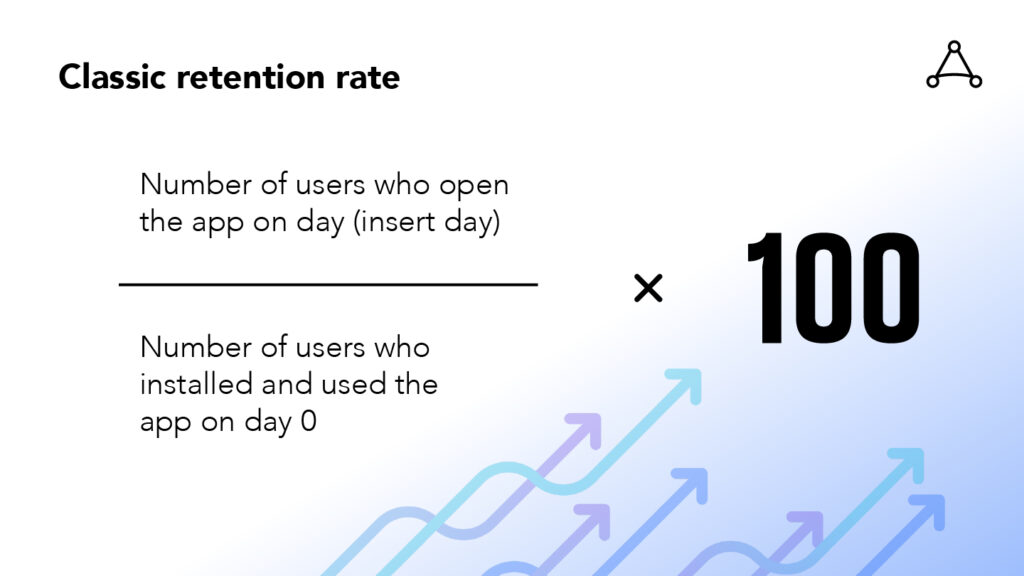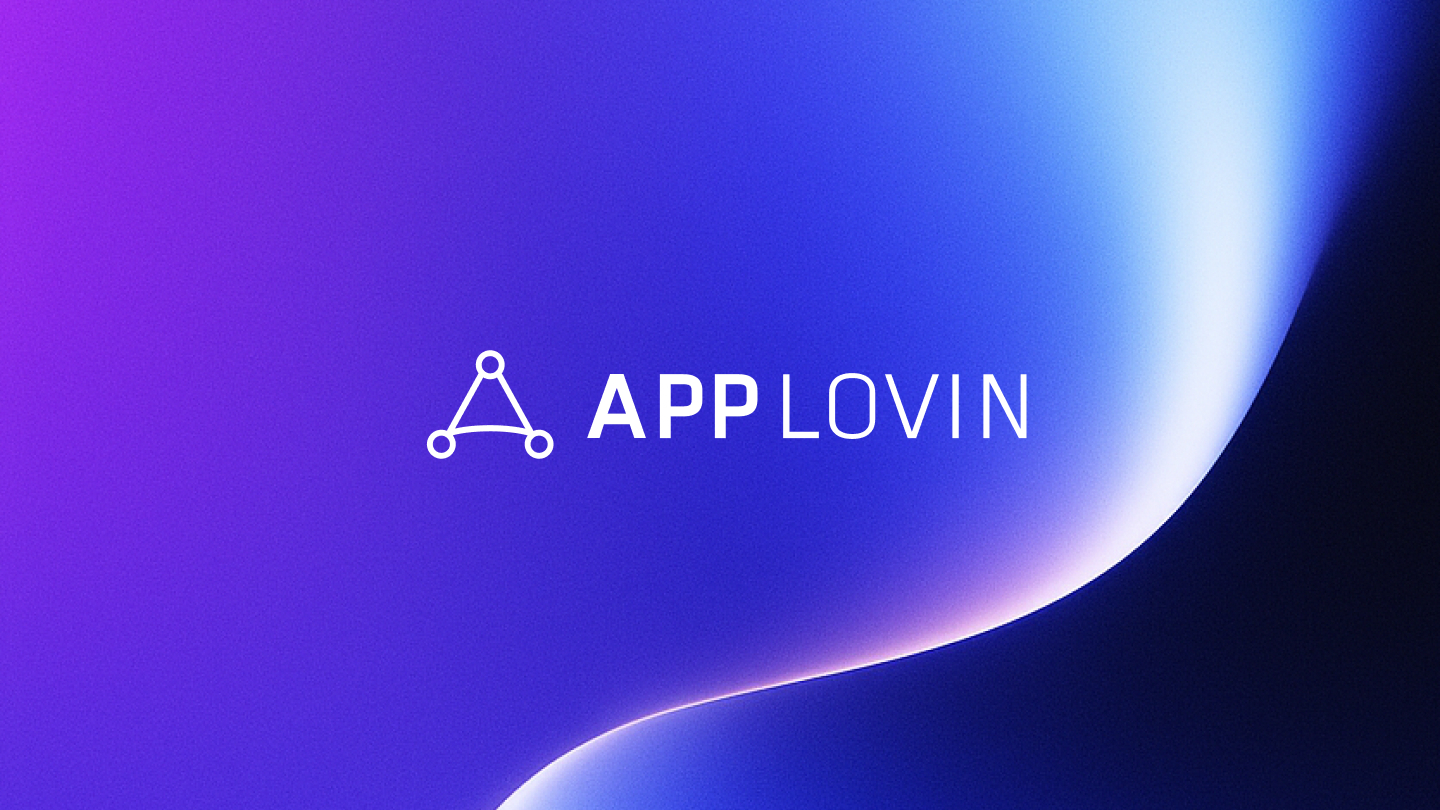When it comes to discussing retention rate, marketers are fond of the legendary stat that states, “It costs five times more to acquire a new customer than it does to retain an existing one.” Whether or not that five percent is exactly accurate, a more reliable source, Bain & Company, has been telling us for decades that “by increasing retention by as little as 5 percent, profits can be boosted by as much as 95 percent.”
What that ultimately means is that focusing on user retention is just as important as user acquisition.
What is retention rate?
In mobile marketing, retention rate is the percentage of users who continue to use your app a certain number of days (usually 30) after they’ve installed it. It’s calculated by counting the unique number of users who are active for at least one session per day, divided by the total installs.
It’s an important success metric because it shows your users’ levels of engagement, interest, and loyalty. A high retention rate usually means customers regularly use your app, which is a good sign. It means your business probably has a low churn rate (or percentage of users who uninstall or leave the app).
A higher retention rate also means you have more potential opportunities for monetization. Conversely, a high churn rate is a red flag and may mean revenue is sinking.
Like many KPIs, or key performance indicators, retention rate helps your business understand how your app is performing. KPIs like retention rate deliver the insights you need to make informed decisions regarding UI improvements, or changes to your campaigns or marketing strategies. Retention rate is also an important factor in determining the lifetime value (LTV) of your app users.
Acquisition and retention: Are you finding the right users?
Acquiring boatloads of new users is exciting, but as mentioned above, investing in retaining current users may be less expensive—and more profitable—than acquiring new ones, assuming you’ve got a solid user base. In fact, retention may reduce acquisition costs that can drag down the customer’s LTV.
Gain a better understanding of how users engage with your app by focusing on user behavior and experience. Pay close attention to onboarding, making it as seamless as possible. This is the first touchpoint after download, and it’s incredibly important! If your app is hard to understand or if the user struggles to figure out how to get started after opening it for the first time, you are likely to see a big drop-off. Statista reports that about 25 percent of app users uninstall after a single use if the app didn’t deliver the expected experience; roughly half of users uninstall within 30 days.
You want to avoid that fate, so make sure you’re targeting the right kind of users. When it comes to UA, quality absolutely trumps quantity. Using data to target the right users will improve your retention odds. (Platforms like AppDiscovery use powerful AI to hone in on users who are likelier to continue using your app after downloading it. You can learn more about it here.)
Here are a few other things you should know about retention rate and why it matters.
Why is retention rate important to businesses?
Retention rate is important because it indicates how your business is doing. A solid retention rate indicates that your app is likely performing well, meeting user expectations, and keeping them engaged. Active, engaged users may result in better opportunities for monetization, particularly if your app is ad-supported or relies on in-app purchases (or both).
Retention rate can help determine:
- How likely it is that you’ll be able to keep newly acquired users
- How long you’ll be able to retain each user if you continue your existing strategies
- How much your company may grow in the future
Note that customer perception and loyalty tend to align with an app’s retention rate. This, in turn, may signal how loyal customers engage with your brand and how likely they are to make repeat purchases or upgrade their subscriptions, for example. Customers who continue to use your app over a long period of time are likely to trust, engage with, and think highly of your company.
Retention rate shows whether you’re solving your customers’ challenges effectively and can be a cost-effective way to upsell and market new products and services.
Lower retention rates help uncover the reasons why users are disengaging from your apps. Leverage the insights from this data to adjust your LTV strategies. Low retention rates may signify problems involving:
- Poor user experience: Users might find the app difficult to navigate, slow to load, or cumbersome to use.
- Low value or relevance: Did the app store listing or UA campaign over-promise on the app’s benefits? If it doesn’t meet the needs or expectations of its users, they will stop using or uninstall your app.
- Insufficient onboarding: How are you greeting your newest users? When they’re not properly introduced to an app’s key features and benefits, users might not see a reason to open it again.
- Performance issues: Bugs, crashes, stalls, and other performance issues can frustrate users.
- Ineffective engagement strategies: Without timely, relevant, and personalized engagement efforts (like push notifications or email marketing), users might forget about your app.
- Strong competition: If competitor apps offer better features, pricing, or user experiences, your users might migrate to them.
- Lack of content or feature updates: Users are bored easily, and apps that fail to evolve with their expectations or introduce new content regularly can become stale.
How are retention rates calculated?
Each company, business, and industry is different, and the definition of what makes for a good retention rate depends on what’s critical to your business. For some apps, for example, it’s about recurring subscriptions, while others focus on in-app purchases. The key is to benchmark your retention against other similar companies in your industry.
There are different ways to measure retention rate, but the classic retention rate measures the following:
Number of users who open the app on day (insert day) / Number of users who installed and used the app on day 0 * 100

Our friends at Adjust suggest studying retention rates at key milestones, like Days 1, 3, 7, 14, 28, and 30. Day 1 is defined as the day after the app’s initial install or opening. The significance of these specific days may vary based on the type of app, so there may be additional or different days you’ll want to review.
What to know about strong retention rates
There’s no standard benchmark for successful retention. It really depends on the app’s industry, user base, business model, and business parameters. Some apps rely on recurring subscriptions while others aim for purchases.
Developers may measure their retention rate over various time periods, but it’s common to examine how retention develops over a month.
The insights from this period can inform future goals. For example, a developer may have a goal to retain users beyond 30 days. In a gaming app, if users most frequently drop off at the end of the onboarding period, the team will likely focus on improving this.
Viewing retention metrics in shorter timeframes, such as days 0-7, can provide a more specific framework for understanding how you’re retaining users (or not).
Three ways to improve customer retention rates
If you want to improve retention rates (and who doesn’t?), here are a few quick tips to get started:
- Consider improving your onboarding process: We mentioned this earlier, but if users find it challenging to understand how to use your app, they may uninstall or quickly bounce from it. Improve usability by assessing how the onboarding information is presented, from the design to the content. Show users which icons need to be tapped or swiped to encourage and help them navigate through the app.
- Re-engage: Invite your users to come back to your app. Request opt-ins for on-device messaging like push notifications or texts, or engage them on external channels via email, social, and search ads.
- User appreciation: How are you rewarding users for their continued loyalty? If you have a mobile game, could you create an event or limited-time tournament with prizes and ways to socially connect with other players? For other apps, consider in-app currency, exclusive skins or icons, or other items with a high perceived value.
Retention rate is an important KPI and can be a good way to check the health of your app business. Moving forward, it’s likely that AI will play an important role in app user retention. Andrey Kazakov, VP, Demand at AppLovin, recently spoke about this in an article for AiThority:
For mobile app businesses, fostering long-term user retention is essential. AI-driven personalization plays a pivotal role. It helps customize features or content to suit specific user cohort’s preferences, making the app more appealing and “stickier. AI can also help improve the onboarding experience, which is the first critical step for user retention.
We anticipate that more companies, particularly those outside of retail, will use AI to analyze and optimize their app onboarding. This is a make-or-break moment in the user’s relationship with an app: If there’s any friction at all, the user may never open the app again. Therefore, creating a delightful onboarding experience is a top priority for any app developer – and AI will become a standard tool to support this pivotal step.
Focusing on retention is smart for many reasons—particularly if your app is ad-supported and/or relies on in-app purchases—and may take some of the pressure off of more expensive user acquisition campaigns. In short, app developers should monitor this metric to monitor how users are engaging with their apps so they can plan for the future, adjust their strategy, and meet their business goals.








